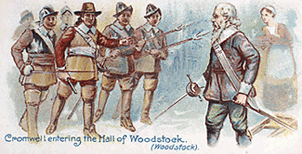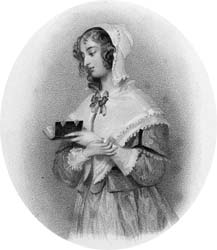|
|
Home | Corson Collection | Biography | Works | Image Collection | Recent Publications | Portraits | Correspondence | Forthcoming Events | Links | E-Texts | Contact Woodstock or The CavalierFirst Edition, First Impression: Woodstock; or The Cavalier. A Tale of the Year Sixteen Hundred and Fifty-one. By the Author of "Waverley", "Tales of the Crusaders", &c. In Three Volumes. Vol. I (II-III). Edinburgh: Printed for Archibald Constable and Co. Edinburgh; And Longman, Rees, Orme, Brown and Green, London, 1826. Composition | Synopsis | Reception | Links Composition
SynopsisThe novel is set in the year 1651 during the English Civil War and revolves around Charles II's escape from the country after the battle of Worcester. Sir Henry Lee, Ranger of the royal lodge and park of Woodstock, and a staunch supporter of the monarchy, opposes the union of his daughter Alice and his nephew Colonel Markham Everard who has sided with the Parliamentarians and earned the respect of Cromwell. Everard is able to prevent the sequestration of Woodstock through his influence with Cromwell, who hopes, moreover, that the fugitive Charles II will choose it as a hiding place where he could easily be captured. Charles does indeed take refuge there, disguised as the page to Sir Henry's son, Albert. He proceeds to court the unwilling Alice to whom he reveals his true identity. The jealous Everard quarrels with Charles, and bloodshed is avoided only by Alice's intervention. Everard is let into the secret of Charles's disguise and promises not to betray him to Cromwell. Cromwell, though, is alerted to Charles's presence, lays siege to Woodstock, and arrests Everard as a traitor. Charles, though, has been forewarned and effects his escape, leaving Albert Lee to impersonate him. Pursuit is further delayed as Charles's followers distract the Parliamentarian forces by 'playing at ghosts' in the secret passages of the supposedly haunted building. When Charles's escape becomes evident, Cromwell orders that Everard and Sir Henry Lee be put to death, but relents and grants them a pardon. Charles's influence meanwhile has helped assuage Sir Henry's prejudice against Everard, and he permits him to marry his daughter. Everard eventually comes to support the Restoration, in the hope that it will bring stable government.
ReceptionDespite the concerns of Scott and Lockhart about potential sales, the novel became an enormous success, and visitors flocked to Woodstock. The critics were less effusive, censuring the 'supernatural'episodes following Charles's escape from the building, and suggesting that Scott was now writing solely for profit. The Westminster Review was particularly hostile, accusing Scott of falsifying history to propagate his political tenets. But Scott cared little for reviews during his financial crisis. He was simply glad the novel was selling well both north and south of the border, and that the general public was enthusiastic. LinksLast
updated: 19-Dec-2011 |
|

 In November 1825, having temporarily laid aside his
biography of
In November 1825, having temporarily laid aside his
biography of 